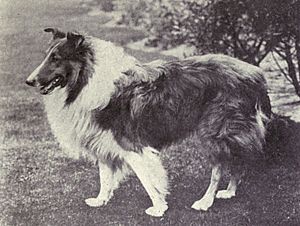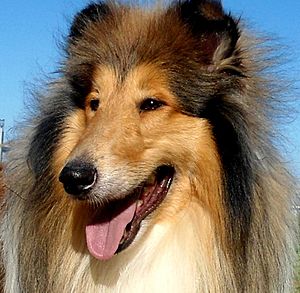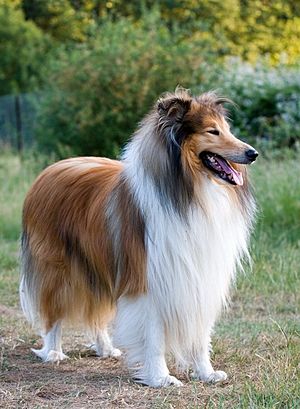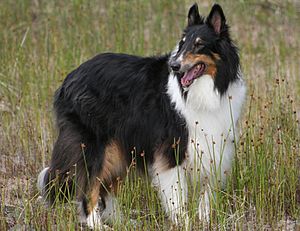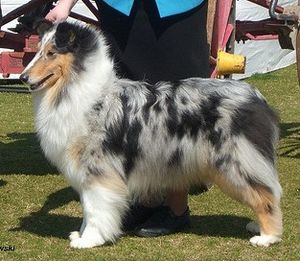Rough Collie facts for kids
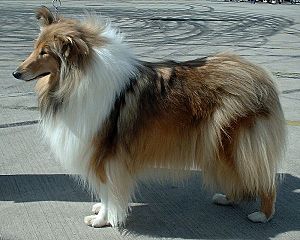
Sable and white Rough Collie
|
|||||||||||||||||||||||||||||||||
| Other names | Collie, Scottish Collie, Long-Haired Collie, English Collie, "Lassie" dog | ||||||||||||||||||||||||||||||||
|---|---|---|---|---|---|---|---|---|---|---|---|---|---|---|---|---|---|---|---|---|---|---|---|---|---|---|---|---|---|---|---|---|---|
| Origin | United Kingdom (Scotland) | ||||||||||||||||||||||||||||||||
|
|||||||||||||||||||||||||||||||||
|
|||||||||||||||||||||||||||||||||
| Domestic dog (Canis lupus familiaris) | |||||||||||||||||||||||||||||||||
The Rough Collie, also known as the Long-Haired Collie, is a medium to large-sized dog breed. These dogs have long coats and were first used for herding sheep in Scotland. They became very popular in the 1800s.
Many people know Rough Collies from books by Albert Payson Terhune, especially his stories about Lad. They are also famous thanks to the Lassie novels, movies, and TV shows. Rough Collies come in several colors. These include sable and white, blue merle, tri-colored, and white. They have a special long, narrow snout and ears that tip over.
There is also a type of Collie with a smooth coat, called a Smooth Collie. Some dog groups, like the American Kennel Club and Canadian Kennel Club, think of rough-coated and smooth-coated Collies as the same breed. Rough Collies look a lot like the smaller Shetland Sheepdog, or "Sheltie." However, they are not directly related in their family tree.
Contents
Discover the Rough Collie's Past
Both Rough and Smooth Collies came from a type of herding dog found in Scotland and Wales. The Scottish Collies were big, strong, and brave. They were bred to herd sheep in the highlands. Welsh Collies were smaller, quick, and friendly. They also herded goats.
When English people saw these dogs at the Birmingham market, they bred them with their own sheepdogs. This created a mix of dogs with both short and long hair. After the Industrial Revolution, owning dogs became popular. People believe these early Collies were bred with the Borzoi (a Russian Wolfhound). This was done to give them a more "noble" head, which means a longer snout. This long snout is now a key feature of the Rough Collie. We are not sure if the Borzoi mix became common in the breed.
When Queen Victoria got a Rough Collie after seeing one at Balmoral Castle, they became very fashionable. Breeding them for dog shows changed how they looked a lot. In the 1960s, they were much taller than they are today in the UK. In the US, their size has stayed the same. Older Collies were also stronger and could reportedly travel up to 100 miles in one day.
In the UK, Rough Collies are no longer used for serious herding. The Border Collie has taken over that job. But in the United States and some European countries, Collies are again being used as working and performance dogs. The Collie Club of America was started in 1886. It is one of the oldest dog breed clubs in the US. The Collie Club in England began in 1881.
In the 1700s, the Rough Collie's natural home was in the Scottish Highlands. They had been used there for hundreds of years as sheepdogs. These dogs were carefully bred to help their owners herd and guard their sheep. By the early 1900s, the American Rough Collie was still developing. The breed continued to do well in England. British imported dogs won most of the American show prizes. Because of these imports, the breed improved quickly between 1900 and 1920. These dogs helped create the Rough Collie we see today. They also led to the rise of famous American kennels in the 1920s and 1930s.
What Rough Collies Look Like
Rough Collies have four main coat colors:
- Sable and white: The "sable" color can be light tan to a deep reddish-brown.
- Tricolor: These dogs are mostly black with tan edges.
- Blue merle: This color looks like mottled gray.
- White: These dogs are mostly white. Their head and sometimes body patches can be tri-color, sable, or blue merle.
All Rough Collies have white fur on their collar, parts of their legs, and usually the tip of their tail. Some may also have white stripes on their faces. The American Kennel Club accepts "white" Collies. These dogs are mostly white with colored markings on their head and sometimes body.
Their soft undercoat is covered by a long, thick, rough outer coat. They have a noticeable ruff (thick fur) around their neck. There is also longer fur around their legs, on their belly, and on their back legs.
One special feature of the Rough Collie is its head. It looks light compared to the rest of its body. The head tapers smoothly from the ears to the black nose. It has a clear stop (where the forehead meets the muzzle) and parallel head planes. The muzzle is round, not square. The color of the head can vary a lot. Their eyes are medium-sized and shaped like almonds.
Their ears are supposed to be "semi-prick" or "tipped." This means the top third of the ear folds over. Ears that do not tip correctly are common. Many Collie puppies have their ears "taped" using medical tape. This helps them lay properly. No cutting or surgery is involved.
Rough Collies have a blunter, more gradually tapering face. This is different from the smaller, but similar, Shetland Sheepdog. The Shetland Sheepdog is partly related to the Rough Collie. In Collies, the top of the muzzle and the top of the skull should be parallel. There should be a slight but clear stop. In Shelties, these planes are not parallel. Rough Collie ears are like a Shetland Sheepdog's, but larger.
Also, once you see them, the difference between a Rough Collie's head and a Border Collie's head is clear. Border Collies have a much shorter muzzle. They also have a more distinct stop between their muzzle and forehead. The ruff (neck fur) also helps tell the two breeds apart.
The size and weight of Rough Collies can vary based on breed standards. Male Collies can stand 55.8 to 66 cm (22 to 26 inches) tall at the shoulder. Females are usually about 5 cm (2 inches) shorter. Males typically weigh between 50–70 pounds (23–32 kg). Females are usually 5 to 10 pounds (2–4.5 kg) lighter. Some Collies in the US are reported to be over one hundred pounds, but a large Collie usually weighs no more than 70 pounds. Standards in the US and UK can be different. The UK standard calls for dogs to be much smaller than those under the American Kennel Club.
Rough Collie Personality and Care
Rough Collies should not be nervous or aggressive. They are generally great with children and other animals. However, they need to be socialized well when they are young. This helps prevent them from being shy. They are medium to large dogs. They usually need a house with a yard instead of a small apartment.
Like many herding dogs, Collies can be quite vocal. Some can be easily trained not to bark too much. Their herding instinct varies. Some dogs are very driven, while others are calmer. Rough Collies are very loyal. They often bond strongly with one family, but they usually make exceptions for children. They are rarely aggressive or overly protective. They might bark to warn you, but they are not usually guard dogs. They are typically excellent with kids. They love to learn and respond best to gentle training.
The Rough Collie's long coat has made the breed successful on farms in the northern Midwest. They are good herders and farm guardians during winter. The dog needs to get used to the cold slowly. They must have a warm, insulated outdoor shelter. They also need plenty of good food and water that won't freeze. Rough Collies also enjoy playing in the snow with children during winter. They guard the farm when the owner is away. They are naturally protective of small children.
Grooming Your Rough Collie
The Rough Collie's double-layered coat needs to be brushed often and thoroughly. This keeps it looking its best, especially for shows. Pet dogs need less grooming, but still a good amount to stay healthy. Their thick coat can pick up grass seeds and burrs. Many dogs tend to get mats (tangled clumps of fur). These often form behind the ears, around the collar, and on their back legs. Spaying or neutering can change the coat texture. It might become softer and more likely to mat.
Rough Collies at Work
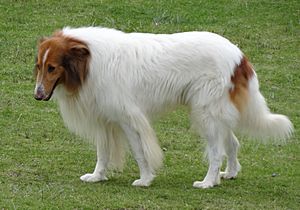
In the 1700s, the Collie's natural home was in the Scottish Highlands. They had been used there for hundreds of years as sheepdogs. These dogs were carefully bred to help their owners herd and guard their sheep.
Collies can be excellent herders. They are also sensible and adaptable family pets. They can work as herding dogs on a ranch or farm. They can also help a suburban owner with a few sheep, goats, or ducks as a hobby. Taking part in herding activities helps keep the Collie's special heritage alive. It also creates new opportunities for both the owner and the dog. The qualities that make a good herding dog are important in many areas. These include being trainable, adaptable, loyal, healthy, agile, and graceful. These traits also make them outstanding companions.
Across the country, there are local herding clubs. They offer clinics, work days, trials, and tests. Several groups offer herding title programs where Collies often compete. A Herding Instinct Test introduces Collies and their handlers to herding at a basic level. It shows if a Collie, even one that has never seen livestock, still has the natural instinct to herd. This is the job the breed was first created for. It is a non-competitive introduction. It uses carefully chosen and easy-to-handle livestock in controlled conditions.
Rough Collie Activities and Sports
Rough Collies can compete in many dog sports. These include dog agility trials, obedience, conformation (dog shows), flyball, tracking, and herding events. Their herding instincts and ability to be trained can be tested in non-competitive herding tests. Rough Collies that show basic herding instincts can be trained to compete in herding trials. This breed has also been known to work as search and rescue dogs. They also serve as therapy dogs and guide dogs for the blind.
Famous Rough Collies

- Lassie: A famous line of Rough Collies. They were first owned by Rudd Weatherwax. These dogs have starred in many films, TV shows, and a radio program. Lassie has also been the subject of many books. Lassie is one of the few animal actors with a star on the Hollywood Walk of Fame.
- Reveille: This is the name of the mascot for Texas A&M University. Since Reveille III became mascot in 1966, every dog with this name has been a Rough Collie. The current mascot is Reveille IX. She was named Twix before she became mascot in 2015. She was given by breeders Marcy and Mike Fine from Overland Collies in Ohio.
- Dog: John Wayne's dog in the 1971 movie Big Jake.
- DR Dakota: This Collie performed the action scenes in the latest Lassie movie.
- Lad: The main character in Albert Payson Terhune's early 1900s novels. These books were about his Sunnybank Rough Collies.
- Pal: The first Rough Collie to play Lassie. All other Lassie dogs are related to Pal.
- Ch. Laund Loyalty of Bellhaven: A nine-month-old Rough Collie. This dog is the youngest ever to win the Westminster Kennel Club Dog Show.
- Colleen: A Rough Collie from London. She was voiced by Tress MacNeille in Road Rovers.
- Jezebel: A Rough Collie voiced by Fergie in the 2010 movie, Marmaduke.
- Chester McDoogle': A Rough Collie who appeared in promos for Chadwick Stokes album Simmerkane II.
- Wilson: A Rough Collie who appears in the Japanese manga series Ginga: Nagareboshi Gin.
- The helpful Rough Collie: From 101 Dalmatians. He leads Pongo, Perdita, and the puppies to a safe dairy farm in Hertfordshire.
- Sledge: A member of Riley's group in Homeward Bound II: Lost in San-Francisco. This was the 1996 sequel to Homeward Bound: The Incredible Journey. She was voiced by Tisha Campbell-Martin.
- Flo: Charlie B. Barkin's girlfriend. She was voiced by Loni Anderson in the 1989 Don Bluth film, All Dogs Go to Heaven.
- Rob Roy and Prudence Prim: Famous snow-white Rough Collies owned by President Calvin and First Lady Gracie Coolidge.
- Laddie: A funny version of Lassie on The Simpsons. He appeared in the episode called The Canine Mutiny.
- Zeb: A dog from Olney, Maryland. He was popular in the mid-Atlantic states as a "spokesdog" for Collie Rescue.
- Mason: This dog played the last "Lassie" in the latest Lassie movie.
- Trigger: This dog appeared in two parts of the Goosebumps episodes, Monster Blood.
- Kep: This dog belonged to Beatrix Potter. He appears in The Tale of Jemima Puddle-Duck.
- Domino: A Rough Collie in the reality TV series Gearz. He is owned by Stacey David.
- Stella: A Rough Collie from the Netflix animated TV series Dogs in Space. She was the Tactical Officer and is now the acting captain of the Pluto of the M-Bark.
See also
 In Spanish: Collie de pelo largo para niños
In Spanish: Collie de pelo largo para niños


